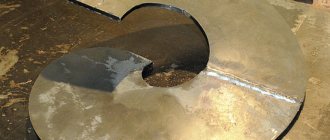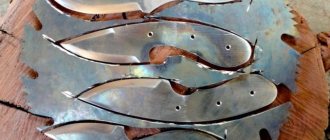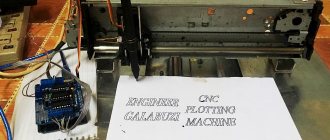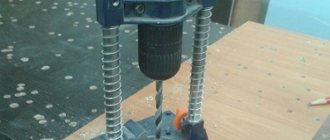Carpenters, joiners, fashion designers, carvers, turners and other manufacturers of wood products sometimes have to make cutters for processing wooden blanks with their own hands. This is not so much an opportunity to save money as it is the need to obtain a cutting tool with a given geometry. A homemade milling cutter for rough processing of any type of wood can be made in tens of minutes or several hours.
What is needed for a router
The tool is used to perform various operations: facing, cutting grooves and holes, incl. on curved surfaces.
For each case there is a special device.
Rip fence for cutting
Due to frequent use, this product is included with all hand-held milling cutters. It allows you to guide the tool along the base surface, which is most often played by:
- edge of the table;
- side face of the workpiece;
- guide rail.
The emphasis consists of the following parts:
- Metal rods. They are inserted into special holes on the router.
- Set screw. Clamps the rods in the holes.
- Fine adjustment screw. It is used to set the distance between the cutting edge of the tool and the base surface.
- Support pads. This is the main part of the stop: when performing an operation, it slides along the base surface.
The rip fence allows you to guide the tool along the reference surface.
In some models, the distance between the support pads can be changed.
To make curved cuts, a block with a round or angular notch on one side is placed between the base surface and the stop. It is oriented so that the straight edge is pressed against the support pads. This method does not provide a firm grip on the tool, so use it with caution.
Guide rails
This type of equipment is used in situations where the tool needs to be moved in a straight line at an angle to the edge of the workpiece. The guide can be equipped with additional structural elements:
- Markings and fasteners. They are used for milling several holes with equal spacing.
- Adapter (shoe). Before performing the operation, the router is screwed to this part; it is embedded in the guide so that it can slide along it.
- Clamps for fastening to a workbench or workpiece. In their absence, clamps are used.
Copy rings and templates
The copy ring is a sleeve that is screwed into the router base or screwed to it so that the cutting tool is inside. This device is used in conjunction with templates. The sleeve is guided along the edge of the pattern, as a result of which the cutter follows its outline.
Copy rings are bushings that are screwed into the base of the router.
The closer the diameters of the cutting tool and the ring are to each other, the more accurately the groove follows the shape of the template. But the sleeve should not touch the cutter. If their diameters are very different, the pattern is cut out to adjust for this difference.
Using a copy sleeve, it is convenient to make curved grooves and also round corners.
The template is attached to the workpiece with clamps or double-sided tape.
Compass
This device is designed for cutting a groove in a circle or ellipse. In its simplest form, it is a narrow plate with a through channel in the middle. A pin with a fixing screw is threaded into it.
At one end the plate is attached to the router. Next, fix the pin at the required distance and insert it into the hole that serves as the center of the future circle.
A design with 2 “legs”, reminiscent of a school compass, is more convenient to use.
If the radius of the circle along which the groove needs to be cut is less than half the width of the router, use another product. It is screwed to the base of the instrument with screws.
The compass is designed for cutting a groove in a circle.
For milling along an elliptical or oval path, a mechanism with the following components is used:
- A fastening screw or suction cup for fixing to the workpiece.
- Two intersecting guides with shoes.
- "Legs."
- Bracket for mounting the router.
Nozzles and tenoning devices
The router allows you to quickly create structural elements for the tongue-and-groove connection. Special devices are also used for this. Among them, the most practical are universal ones - capable of making a groove with a dovetail, straight, T-shaped, etc. profile. They have a copy ring and a template in which it moves.
For fast and high-quality slot milling
There are attachments that allow you to cut grooves with a router on narrow edges, for example, for door hinges or lock elements. The product consists of a plate (screwed to the tool) and 2 guide rods, between which the workpiece is placed. If it is necessary to cut a groove offset from the midline, a sleeve of the required diameter is put on the corresponding pin.
There are attachments for fast and high-quality milling of grooves.
In the absence of a nozzle, bars are attached on both sides of the workpiece so that the edges of all 3 elements lie in the same plane. This will turn the narrow surface into a wide one, allowing you to cut the groove using the rip fence.
Special kits
Separately there are kits for performing special work - for example, a device for inserting hinges. The device is an individually made or customized template for this type of milling, equipped with specially designed fasteners that secure the tool at the end of the door leaf.
Homemade device for inserting loops
As a rule, such templates are made independently. Any highly specialized carpenter tries to have an individual set, especially if the work is carried out on the customer’s premises.
Hinge cutters
There are also standard accessories for hinges, in the form of special cutters. You don't need a template to work with them.
Door hinge cutter
When performing home renovation work, you can get by with simpler methods of cutting niches for hinges or grooves for a lock. It is enough to install a second parallel stop on the rods and then the router will be securely fastened to the end of the door leaf. This method is less convenient and is not suitable for mass production of doors, but for one-time work it will save money on purchasing a special kit.
Binding cutter set
A set of cutters specifically for a specific type of work
There are also sets of cutters, each of which cannot be used separately. In such sets, the sharpening of the tips is synchronized, and each subsequent cutter complements the work of the previous one. Let's take a bookbinding kit as an example.
Binding made by a set of cutters
It is by using all the cutters from the set that you can get a joint without gaps. To increase the versatility of application, typesetting cutters are available.
Universal typesetting cutter
Several complementary cutting attachments are attached to the axis, the arrangement of which can be combined. At the same time, with one set you can perform work that requires several attachments. Thus, using a variety of devices for a manual router, you can do complex woodworking with your own hands without using stationary milling machines. This issue is especially relevant when living in an apartment, when it is impossible to find a place to place the machine. And with the help of a hand router with a good set of attachments and additional accessories, you can organize a mini-workshop on the balcony. Only when working indoors, it is necessary to ensure removal of dust and sawdust.
Read also: Input capacitance of a field-effect transistor
How are bodies of revolution processed?
The factory kit does not include a device for a router that allows you to cut grooves in cylindrical and conical workpieces. But home craftsmen have learned to make them themselves.
The product consists of the following parts:
- Cases.
- Movable milling carriage.
- Disk for adjusting the angle of rotation.
- Clamp for fastening the workpiece.
- Set screw.
The mechanism can be turned into a lathe by connecting an electric drill or screwdriver to it.
Types of cutters
For processing wood, board and composite materials based on it: chipboard, OSB, MDF, plywood and others, two types of cutters are used:
- End - clamped using a collet clamp. They have a shank like a drill and a cutting part of any configuration. They are used with manual routers, including those built into a table or stand, pantorouters on their base, and CNC machines.
Factory equipment
- Mounted or disk - made in the form of disks of any thickness. Designed for cutting grooves, tongues, quarters, profiling lumber and finished products. Installed on the shaft of a vertical milling or circular machine.
Mounted models
- Milling heads or drums are a tool for profiling lumber.
Drum with knives
How to make templates with your own hands
The pattern is a flat part. Its dimensions are selected taking into account the difference in the radii of the cutter and the copy ring.
Ready drawings
There are many patterns posted on the Internet for different tasks and sizes of the copy sleeve. Most publications are provided with formulas into which you need to substitute the dimensions of your workpiece. All that remains is to calculate the dimensions of the template, draw it on graph paper and transfer it to sheet material.
Drawing of a copy sleeve.
Examples of drawings are shown below.
What you need
Stencils are made from the following materials:
- tool steel (the most durable option);
- duralumin;
- plastics;
- plywood;
- plexiglass.
Sheet thickness – from 2 to 10 mm.
Tools needed:
- drill with a set of drills;
- jigsaw or hacksaw;
- file;
- grinding wheel.
To make stencils you need a drill with a set of drills.
Manufacturing process
Proceed in this order:
- Draw the outer contour of the groove on the sheet stock.
- Calculate the difference between the diameters of the cutter and bushing and divide it by 2.
- From the drawn outline, retreat a distance equal to the number obtained in step 2 and draw a parallel line.
- Cut out a template using it.
- File and sand the edges of the product.
A curved template is cut in this way: first, a series of small holes are drilled along the contour, then the material between them is removed with wire cutters or another suitable tool.
Features of a homemade wood cutter
Not every profile cutter is sold in the nearest store; a tool ordered in China or for individual production will have to wait a long time, and in the second case, you will also have to pay a lot. It is much easier to make it yourself.
To create a homemade cutter on a manual or vertical milling machine for wood processing you will need:
- The material is durable, heat-resistant steel that holds an edge well.
- An angle grinder or grinder with a cutting wheel for metal.
- Electric sharpener or other grinding tool.
- Vise.
- A drill or screwdriver and a welding inverter are not always needed.
The first copies will not satisfy the quality of surface treatment and geometry. May have poor balance - exhibit noticeable runout, leave a “dirty” rough surface due to incorrect sharpening angles or insufficient sharpness of the cutting edge. After manufacturing and finishing several cutters, the result will begin to please you.
DIY accessories for a router
Most products can be made independently. The manufacturing procedure for the most popular ones is outlined below.
Tenoner
Proceed like this:
- On both sides of the plywood strip, install identical racks of blocks with notches in the middle.
- Attach router guides equipped with stops to them on the top, bottom and sides.
- Install a movable element on the plywood base to regulate the size of the edge of the part, equipped with a wing nut or other lock.
Tenoners are used to perform precise operations.
An alternative device is a conductor.
It consists of the following parts:
- grounds;
- stops;
- movable slide.
The product is used to perform small operations that require high precision.
Copy sleeve
The preferred material is tool steel. But in private workshops, due to the lack of professional metalworking equipment, bushings are most often made of simple steel or duralumin.
Procedure:
- Cut a circle from a metal plate with the same diameter as the hole in the router base.
- Take a piece of pipe with an internal cross-section 2–4 mm larger than the cutter and cut it off.
- Sand the bushing with oil sandpaper.
- In a metal circle, cut a hole in the middle with such a diameter that the sleeve fits tightly into it.
- Weld the flange to the sleeve or connect them by riveting the ends and pre-seating them with glue.
Another option is practiced, for which you need:
- steel or duralumin washer;
- plumbing extension cord;
- nut with the same thread as the extension.
The copying sleeve is made of tool steel.
They do this:
- Cut the nut to make a ring and grind it through.
- A circle is cut out of steel or aluminum 2 mm thick.
- The metal is removed along the edge on a sharpening machine.
- Place the circle on the base of the router.
- Place the tool vertically.
- Markings for fastenings are applied through the holes in the sole.
- Drill holes with a thin drill, then enlarge them with a tool of the required diameter.
- Put on the washer and screw in the nut.
- Holding the workpiece in a vice, gradually remove the thread with a grinder so that it is flush with the nut.
- The product is trimmed.
- Align the bushing on the grinding wheel and attach it to the router base.
Guides for working with a router
The simplest homemade guide looks like a rail attached to the workpiece with clamps. You can fix several parts at once and make a groove in them in 1 pass.
A more complex option is a structure made from a board and a sheet of plywood that serves as a base. With this design, it is easier to accurately fix the guide on the cutting line.
If milling cutters of different sizes are needed to process the workpiece, use the option with a folding bar. It is attached to the board base using door hinges.
Will need
We only need two M8 bolts and a washer with an outer diameter of 35-45 mm. By the way, the size of the bolt depends on the problem being solved. In our case, we select the future tool for a Forstner cutter to match the holes for a small ball bearing. It must be secured flush with the plane of the base. We will also make a clamp for pressing the element into the wood.
So, let's arm ourselves with power tools:
- Grinder (angle grinder) with cutting and grinding abrasive discs.
- Drill.
- Electric welding machine.
- Vertical drilling machine.
The hand tools we will need are: a file, a marker, and a caliper. Well, a workbench with a vice can be found in every workshop.
This is interesting: Making a stand for a drill with your own hands: instructions, drawings, video
Tools and materials
So, to create a wood cutter with your own hands, you will need to have a pair of M8 bolts, as well as a washer with an outer diameter of about 4 centimeters. Naturally, the sizes of the bolts will depend on the problems that need to be solved. If we are talking about a tool for a Forstner cutter made from a drill, then you should take into account that it must have holes for a small ball-type bearing. It should be attached flush with the base plane. In addition, you will need to make a clamp, which will allow you to press the element into the wood.
The tools you will need to have on hand are:
- drill;
- vertical drilling machine;
- electric welding machine;
- angle grinder with abrasive discs of grinding and cutting type.
If we talk about hand tools, you will need:
- calipers;
- marker;
- file;
- Desktop;
- vice.
The simplest clamp for pressing
We will make this device from the same M8 bolt and a washer of suitable diameter. We place the bolt vertically on a metal surface, providing mass contact for electric welding. We place the washer on top in the center of the bolt head, holding it with pliers. We scald the center with an electrode, filling the area of the inner hole of the washer.
We clamp the resulting clamp in a vice and clean it with an angle grinder. The back part can be passed with a cleaning brush attachment for a drill.
We insert the finished clamp into the chuck of a vertical drilling machine, and try to press the bearing into the wood. This simple device will save you unnecessary effort and allow you to accurately handle such tasks.
Adviсe
Let's talk a little about tips that should be taken into account when creating homemade cutter models.
- To give the cutting area the correct configuration, you will need to use diamond-coated needle files or angle grinders with discs that are used specifically for working with metal.
- The edge for cutting should be sharpened at a 7-10 degree angle. If you make it sharper, then it will hold an edge poorly, which is why its cutting properties will significantly decrease.
- If a wood cutter made by yourself must have some kind of complex device, you can flatten it or bend it.
- When using an edge router, take into account that the guide ring or bearing is already installed.
- The cutter must be secured in the collet before starting work.
- The presence of additional accessories will help increase the power of the electric tool.
- The part to be processed must have some kind of support.
- When carrying out work, the correct insertion depth level should be set.
- To prevent too much dust from being generated when working, you can use a vacuum cleaner.
In general, it should be said that creating a wood cutter yourself is not difficult. True, it should be understood that in this way you can quickly solve some simple problem, because for hardware such as bolts, ordinary steel is used, not tool steel. This means that such a homemade cutter will quickly wear out. But its life can be significantly extended in a number of ways.
Therefore, this solution has a place and should be used in cases where you really need to quickly acquire a pretty good wood cutter in order to get the desired result.
Common Techniques
The most widely used techniques for routing wood are leveling the surface, making grooves, routing the edge and working from a template. More often than others, working according to a template is used. This technique involves precisely sliding the copy sleeve along the edge of the stencil. This method of work makes it much easier to make keyways, trims, figured cuts, cutting parts, and making decorative elements. The template is made from plywood 8-12 mm thick. A design is applied to it and cut out with a jigsaw. Using a template, you can make any intricate pattern, carve out small details, and copy the required number of identical fragments of a product. The router moves along a fixed template with high precision, which allows you to reflect the desired high-quality result on the wooden surface.
Edge milling can be done with or without a template. For this purpose, straight edge cutters are used. The template can be any flat board longer than the workpiece being processed. This is necessary to prevent the formation of irregularities along the edges of the edge.
To make a curved edge, you need to prepare the surface. First of all, you need to level the edge of the workpiece to be processed using a straight edge cutter. Otherwise, it will repeat the curvature of the edge along the edge of which the roller will move. After this, you need to make a template with the desired pattern. It is fixed on the working surface and cut along the contour. If you need to remove a large layer to obtain the required pattern, then use a jigsaw, and the finishing work is done with a milling cutter, otherwise it will quickly become dull.
Using a figured (fillet) cutter, you can make a longitudinal pattern on a wooden workpiece. This can be done using a template or a special stop.
By studying the milling device and learning how to use it correctly, you can greatly simplify and speed up carpentry work, while simultaneously increasing its quality. And wood carving, made by hand using a router, will decorate the interior and become an object of pride for the work done.











